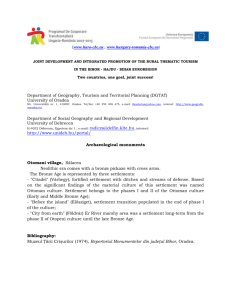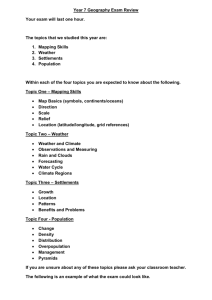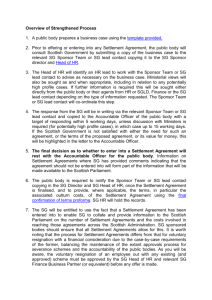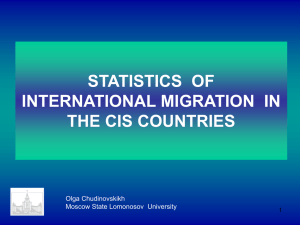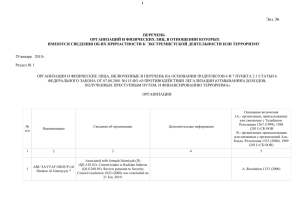Mordvin Settlement Names of the Trans
advertisement
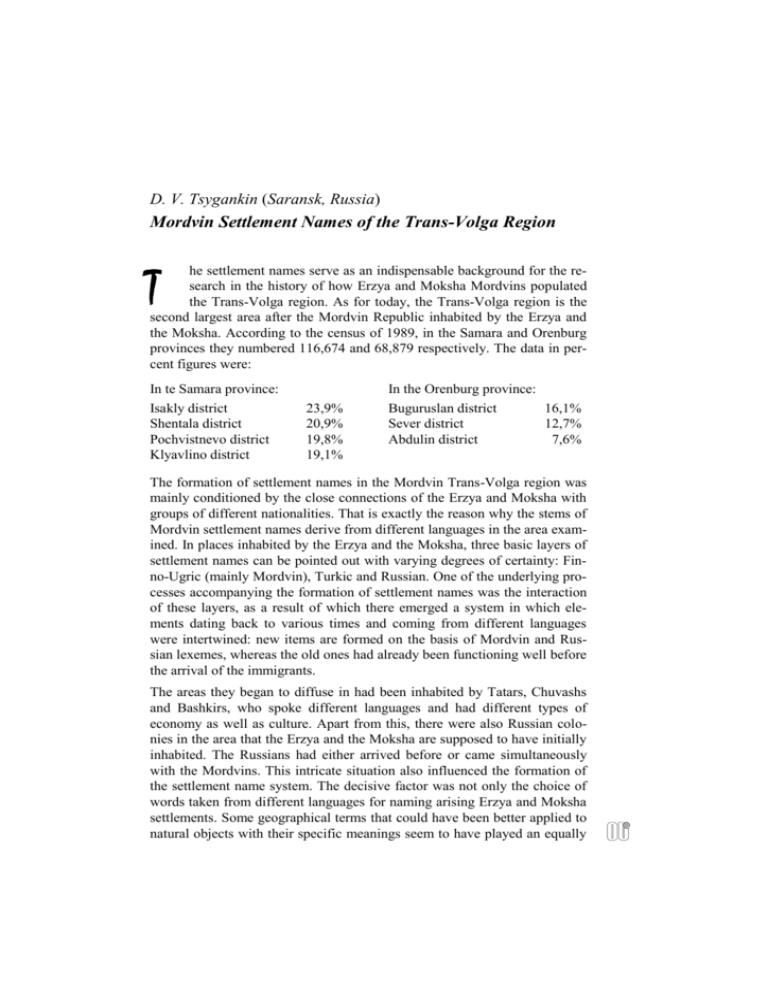
D. V. Tsygankin (Saransk, Russia) Mordvin Settlement Names of the Trans-Volga Region he settlement names serve as an indispensable background for the research in the history of how Erzya and Moksha Mordvins populated the Trans-Volga region. As for today, the Trans-Volga region is the second largest area after the Mordvin Republic inhabited by the Erzya and the Moksha. According to the census of 1989, in the Samara and Orenburg provinces they numbered 116,674 and 68,879 respectively. The data in percent figures were: T In te Samara province: Isakly district Shentala district Pochvistnevo district Klyavlino district 23,9% 20,9% 19,8% 19,1% In the Orenburg province: Buguruslan district 16,1% Sever district 12,7% Abdulin district 7,6% The formation of settlement names in the Mordvin Trans-Volga region was mainly conditioned by the close connections of the Erzya and Moksha with groups of different nationalities. That is exactly the reason why the stems of Mordvin settlement names derive from different languages in the area examined. In places inhabited by the Erzya and the Moksha, three basic layers of settlement names can be pointed out with varying degrees of certainty: Finno-Ugric (mainly Mordvin), Turkic and Russian. One of the underlying processes accompanying the formation of settlement names was the interaction of these layers, as a result of which there emerged a system in which elements dating back to various times and coming from different languages were intertwined: new items are formed on the basis of Mordvin and Russian lexemes, whereas the old ones had already been functioning well before the arrival of the immigrants. The areas they began to diffuse in had been inhabited by Tatars, Chuvashs and Bashkirs, who spoke different languages and had different types of economy as well as culture. Apart from this, there were also Russian colonies in the area that the Erzya and the Moksha are supposed to have initially inhabited. The Russians had either arrived before or came simultaneously with the Mordvins. This intricate situation also influenced the formation of the settlement name system. The decisive factor was not only the choice of words taken from different languages for naming arising Erzya and Moksha settlements. Some geographical terms that could have been better applied to natural objects with their specific meanings seem to have played an equally 86 D. V. Tsygankin or even more important role in the process. This, in its turn, left its mark on all the system of settlement names, which means that a number of Erzya and Moksha lexemes instrumental to the formation of settlement names in the Trans-Volga region differ from those which formed the basis of settlement names in the area where the Mordvin immigrants had formerly spread, either because some of them had a low frequency of occurrence or because the difference was stipulated by the formation of the settlement name standard. Geographical terms like Erzya лей, Moksha ляй ’river’, Erzya кужо, Moksha кужа ’clearing’, Moksha пора ’grove’, Erzya пумбра ’natural boundary between two adjacent areas’, Erzya эрьке, Moksha эрьхке ’lake’ and others, all of which were basic components of settlement names in areas formerly inhabited by the Erzya and the Moksha, were not used in settlement names that had sprung up in the new territory. Settlement names arising here included words unrelated to the Mordvin languages. Some of them are connected with the Turkic languages, whereas others reveal Russian features. The settlement names of Turkic origin are semantically rather transparent. To quote a few examples, it will suffice to point out: Бакалка ~ Алексеевка (Ponom.) < Tatar бакала ’lake with frogs’ Булатовка ~ Буланка (Abd.) < Turkic personal name Булай Емантеево ~ Емантай веле (Abd.) < Tatar ементай ’big hill’ Зерикла (Abd.), the name derives from the hydronym Ирикла < Turkic ирик ’bend, winding river-bed’ (MURZAEV 1984: 235) Камыш-Садак (Abd.) < Tatar personal name Садык Малый Сурмет (Abd.) < Tatar су ’river’ + урема ’flood-lands of a river overgrown with leaf-bearing forests’ Новая Тяба (Ch-Versh.) < Turkic тюбя ’top (of head), peak’ Новое Уреметьево (Ch-Versh.) < Turkic арама ’scanty forest overgrowth’ (MURZAEV 1984: 580) Новый Байтермиш (Isak.) < Turkic personal name Байтермир Новый Казбулат (Klyavl.) < Turkic personal name Хазбулат Новые Услы (Ponom.), Новые Узели (Abd.), named after the hydronym Узала < Turkic ’brook, channel, river-bed’ Старая Бинарадка (Krasn.) < Turkic personal name Бинарий Старый Маклауш (Klyavl.) < Turkic махла ’settlement, tiny village’ Узюково (Stavr.) < Turkic ’old river-bed’ Below are listed Turkic names without a reference of their internal form (see in the Spisok): Бугульма, Верхний Курмей, Чигирла, Камышла, Ик (Abd.); Асабино, Иркуль, Мордовский Бугуруслан, Сабовка, Турханка (Bugur.); Тимяшево (Ch-Versh.); Аделоидовка, Верхняя Шентала, Карабикулово, Каргал, Новое Суркино, Семено-Шарла, Тюбек (Klyavl.); Кабельма, Шилан (Krasn.); Таранки, Шелехметево (Samar.); Верхний Сускан, Mordvin Settlement Names of the Trans-Volga Region Пискалы (Stavr.); Аделяково, Асказанка, Верхняя Кармала, Старое Мансуркино (Stal.). There are several reasons for the high representation of Turkic names in the settlement name system of the Mordvin Trans-Volga region. Part of the Erzya and Moksha that had arrived in the area did not set up new settlements at first but joined existing Turkic ones, thus making them more populous. Far-reaching processes of assimilation began almost immediately, subsequently turning these villages either Erzya-speaking or Moksha-speaking ones. Another group of immigrants into Trans-Volga founded new settlements on banks of streams and rivers that had Turkic lexemes in their names, which then became settlement names. As noted above, the settlement name system of the Mordvin Trans-Volga region consists of heterogeneous components, the Mordvin factor being one of them. In the official oikonymy of this area Erzya and Moksha linguistic traces are, however, insignificant and hardly discernible. Those which are contained in the “Spisok” are basically related to Mordvin pre-Christian personal names, like the following: Ведяево ~ Ведяй веле (Klyavl.) < personal name Ведяй to be found as a stem in the surnames Ведяйкин, Ведяев Кирюшкино ~ Кирюш веле (Bugur.) < personal name Кирюш Нуйкино ~ Нуя веле (Bugur.) < personal name Нуя Парадеево ~ Парад веле (Sharl.) < personal name Парадей Симдянов ~ Симдян (Krasn.) < personal name Симдян Старое Вечканово ~ Вечкан веле (Isak.) < personal name Вечкан, surviving as a stem in the surnames Вечканов, Вечкаев Тремасовка ~ Тремаз веле (Krasn.) < personal name Тримас Юртаево (Sharl.) < personal name Юртай There are a few recorded Mordvin Trans-Volga oikonyms in whose formation appellatives belonging to the Erzya linguistic world played a role. In the “Spisok” the following are included: Большая Левшинка (Bokl.) < большая ’big’, левш ’bast’ Верхние Кузлы (Ponom.) < верхние ’upper’, куз ’fir-tree’ Ега (Stal.) < Proto-Mordvin ёв ’river’ Кувак (Bokl.) < кувака ’long’ Од Эрямо (Bugur.) < од ’new’ + эрямо ’life’ Салолейка (Bokl.) < соламс ’thaw (v.)’ + лей ’river’ Чей Пильге (N-Cherk.) < чей ’sedge’ + пильге ’foot’ Чеменка (Bokl.) < чемень ’rust’ No less important is the other component of the Trans-Volga oikonymy: Russian. It can be pointed out in numerous oikonyms andconstitutes the 87 88 D. V. Tsygankin basic positive characteristic feature of the system of settlement names in the area studied. The positive aspect follows from the minute reflection of reality, such as that of landscape and relief, etc., in the settlement names. Oikonyms included in the “Spisok” convincingly prove what has been said and offer an opportunity to sort out the material at our disposal in a logical succession. 1. Topography and hydronymy of the area: Виловатово (Bor.); Ключ, Ровный, Устье (Bokl.); Каменка, Озеровка, Суходол (Bugur.); Ключовка, Три Ключа, Холодный Родник (Klyavl.); Высок-Колка, Степной (Koshk.); Верховая, Высокая Грива, Крутогорский, Обрезки, РовноОвражный (Krasn). 2. The location of a settlement in relation to another object: Заозерный, Подлесная Андреевка (Ch-Versh.); Подлесье (Koshk.); Дальнее Поле, Мельничный Угол (Krasn.); Верхне-Ягодное, Средне-Ягодное (N-Cherk.); Завязовка, Нижняя Кармалка, Средняя Алексеевка (Stal.). 3. Flora. There are about 15 varieties of trees and shrubs that are contained in the names of Mordvin-speaking settlements. The most frequently occurring ones are birch, lime, oak, fir, alder, raspberry, hop and others: Березовка, Вишневая, Дубовая, Ягодная, Малая Береза (Bokl.); Елховый Ключ, Малиновка, Садовка (Bugur.); Новая Вязовка (Buzul.); Вязовка, Липовка, Сосновый Овраг (Klyavl.); Елховая Поляна, Липовый, Орешенка, Сосновка, Яблонка (Krasn.); Камышовка (N-Cherk.); Красная Дубровка (Stavr.); Елшанка (Tock.). 4. The size of a settlement: Малое Алпаево (Bokl.); Большая Каменка (Krasn.); Старое Мансуркино (Stal.). 5. Fauna. Erzya and Moksha settlements named after animals are extremely rare. What can be referred to here is: Медвежевка (Bokl.); Сорокин Ключ (Bugur.); Лебяжье Товарищество (Buzul.); Грачевка (Koshk.); Линевой (Krasn.). The categories listed above can be called “objective” in the sense that oikonyms derived by their means reflect natural, geographical, topographical and other feaures that are typical of the Mordvin settlements of the Trans-Volga region where there is an Erzya and Moksha population. Anthroponymic settlement names principally from the groups listed above. Such names can be classified in the following way: 1) the denomination based on the names and surnames of the first settlers; 2) it is often derived from a nickname of an inhabitant of the settlement in question; 3) it is underlied by an aboriginal surname, e.g.: Васильевка, Гавриловка, Глаголевка, Михайловка, Новая Егоровка, Петровка, Федоровка (Abd.); Бестужевка, Куликовка, Наумовка, Пашкино, Трифоновка, Фомичевка, Ша- Mordvin Settlement Names of the Trans-Volga Region тановка (Bokl.); Астафьевка, Долгоруково, Сенькино (Klyavl.); Александровка, Любовка, Прохоровка, Раевка, Степановка (Koshk.); Васильевский, Владимировский, Георгиевский, Ивановский, Соболевский, Уловский, Хомутовский (Ponom.); Ивановская, Ромадановка (Stal.). A special group is made up of oikonyms formed on an ideological basis. This type can be called social-ideological and acquired a great importance after the revolution. Such oikonyms are not motivated by any specific features of geographical objects and are symbolic or dedicational in character: Ильич, Искра ’spark’, Новый Свет ’new world’ (Abd.); Знаменка ’flag’, Идеал, Красный Колос ’red ear of corn’, Прогресс, Секретарка ’secretary (fem.)’, Труженик ’worker’ (Bokl.); Красный Флаг ’red flag’, Пожарная Борьба ’fight against fire’, Путь Просвещения ’way of enlightenment’, Спутник ’companion’ (Buzul.); Аврора ’aurora’, Красный Инвалид ’red invalid’, Маркс, Молот ’hammer’, Путиловец ’worker of the Putilov factory in St. Petersburg’ (Koshk.); Пахарь ’ploughman’, Путник ’traveller’, Земледелец ’farmer’ (Krasn.); Активная ’active (fem.)’, Красный Маяк ’red lighthouse’, Светлый Путь ’bright way’ (N-Cherk.); Культура ’culture’, Труд и Братство ’work and fraternity’ (Samar.); Восток ’east’, Красная Береза ’red birch’, Пролетарий ’proletarian’ (Ch-Versh.) and others. In all these names, their creators’ free initiative, aesthetic tastes and demands are embodied. A number of the names listed above are not to be found in the present-day maps of the Samara and Orenburg provinces, for the settlements they referred to have disappeared. The figures in “Spisok” show that 156 of the 244 Mordvin settlements in the Trans-Volga region were of the “поселок” type, which was the most widespread in the 30s. The oikonymy of the Mordvin Trans-Volga region has several imported names, too. These are the milestones by which former migrations of the Erzya and the Moksha can be judged. Imported settlement names, attesting to migrations within the area as well as between provinces, can be found in various parts of the area studied. For example, the oikonym Кабаево, mentioned in the “Список населенных мест Симбирской губернии” (1863) [List of Inhabited Locations of the Simbirsk Province], was imported by the migrating Erzya into the TransVolga region from the settlement bearing the same name in the Dubenskij district of the Mordvin Republic. The settlement name Boľshije Remezenki, redorded in the “Список населенных мест Пензенской губернии” (1869) [List of Inhabited Locations of the Penza Province], was imported into the Toickij district of the Orenburg province and registered in the “Spisok”. Now it is the name of the Erzya-Russian village Большие Ремезенки. The oikonym Парадеево was imported from the former Ardatov district to the Sharlyk district of the Orenburg province; in the Mordvin Republic, this 89 90 D. V. Tsygankin name is given to a village in the Ichalkovo district. The oikonym Темяшево, registered in the former Lukoyanov district, can now be found in the Chelno-vershiny district (Тимяшево); there is also a village by that name in the Staroshajgovo district of Mordvinland. There are several oikonyms reflecting the internal migration of the Erzya and the Moksha within certain districts of the Mordvin Trans-Volga region. These typically carry the first element Малое ’small’ and Новое ’new’. The locations that took such names were, as a rule, situated in the neighbourhood of the settlement with the primary name (Малое next to Большое ’big’, Новое next to Старое ’old’): Большой Сурмет – Малый Сурмет; Старая Тепловка – Новая Тепловка; Старое Суркино – Новое Суркино and others. The attributes Малое and Новое, however, are not connected with Большое and Старое in each case, e.g.: Новое Вечканово and Вечканово (Klyavl.); Старая Шентала and Шентала (Koshk.). Word formation models used for creating new settlement names are various: 1) Toponymization of appellatives, i.e., their reinterpretation in a way that one and the same word carries two meanings, an appellative one and an oikonymic one: нива ’(ploughed) field’ and Нива (oikonym Abd.); долина ’valley’ and Долина (oikonym Buz.), etc. 2) Suffixation. The spectre of oikonymic suffixes is not too varied: in noun oikonyms -овка/-евка, is the most frequently used one, whereas -ск is taken mostly by adjectives: Екатериновка, Молчановка (Bokl.); Бухаревский, Радаевский (Bugur.) and others. 3) Substantivization of adjectives: Горный, Родной (Andr.); Луговой, Ямской (Bokl.), etc. 4) Compounded abbreviations: Красногорка, Самопомощь (N-Cherk.); Райгород (Koshk.) and others. 5) Word combinations: Дектярный Раг, Каменный Ключ, Мельничный Угол (Krasn.); Нижнее Матюшкино (Stavr.); Путь Просвещения (Buzul.), etc. It should be noted in conclusion that the settlement names of the Mordvin Trans-Volga region exist in a Russian phonetic and graphemic envelope. At the same time, no Erzya of Moksha village is restricted to a Russian form only on the level of expression. Russian oikonyms do have objectively existing Mordvin counterparts in their national forms. Their catalogueing is one of the most important and topical issues of Mordvin toponymic studies. Mordvin Settlement Names of the Trans-Volga Region Abbreviations Abd. Andr. Bokl. Bor. Bugur. Buzul. Ch-Versh. Isak. Klyavl. Koshk. Krasn. N-Cherk. Ponom. Samar. Sharl. Stal. Stavr. Tock. Абдулинский район Андреевский район Боклинский район Борский район Бугурусланский район Бузулукский район Челны-Вершинский район Исаклинский район Клявлинский район Кошкинский район Красноярский район Ново-Черкасский район Пономаревский район Самарский район Шарлыкский район Сталинский район Ставропольский район Тоцкий район References Mordva (1944) = Мордва Заволжья. Саранск. MURZAEV, E. M. (1984) Мурзаев, Э. М. Словарь народных географических терминов. Москва. Spisok (1931) = Список населенных пунктов Средне-Волжского края. Самара. 91





